The Coming of Conan Re-Read: “The Phoenix on the Sword”
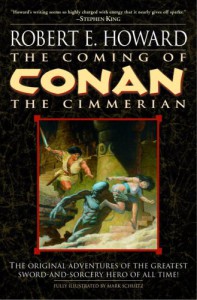 Bill Ward and I are reading our way through the Del Rey Conan collection The Coming of Conan. This week we’re discussing “The Phoenix on the Sword.” We hope you’ll join in!
Bill Ward and I are reading our way through the Del Rey Conan collection The Coming of Conan. This week we’re discussing “The Phoenix on the Sword.” We hope you’ll join in!
Howard: Look at the story’s opening quote. That’s practically the gold standard of quotes from imaginary historical sources. That fabulous “Know, O Prince” and all that follows has been imitated but rarely, if ever, equalled. This, fellow fantasy fans, is the way it’s done. Admittedly, there are a few phrases in the middle of the paragraph that are less inspired. I’m looking at “Zingara with its chivalry, Koth that bordered on the pastoral lands of Shem.” Most of the rest of the quote paints lovely word pictures, but those phrases don’t remotely approach the poetic majesty of the rest — what does Zingara look like? What does Koth look like? But the rest is lovely, and the quality picks right back up with “dreaming west” and powers on to that fantastic finish, “Hither came Conan…”
Bill: Classic stuff, and apparently put there in the final draft at Wright’s insistence that Conan’s identity and the setting itself needed to be established earlier on in the story. Philistine that I am, I can never read it without hearing it in Mako’s voice, as it was also paraphrased at the start of the Milius Conan the Barbarian film.
Howard: I’d forgotten that was at Wright’s behest! And I, too, hear Mako’s voice.
Look at the opening line of the story: “Over shadowy spires and gleaming towers lay the ghostly darkness and silence that runs before dawn.” Damn. Why doesn’t anyone write like that any more? Howard sets the scene with sharp, sensory laden description. He’s a film director guiding the camera with a fantastic establishing shot.
Unfortunately, a lot of Part I feels a little old fashioned because it’s a fairly staged conversation to convey information we, the readers, need to know about what the villains are planning. This kind of information delivery is a pulp standard, and it was perfectly acceptable at the time of writing, but it hasn’t aged well. Even still, Part I is loaded with brilliant bits, one of my favorites being the discussion of Rinaldo and the habits of poets who seek perfection “behind the last corner, or beyond the next.”
Bill: Yes, “a poet always hates those in power.” This is one of the many things that survives from “By This Axe I Rule,” the unsold King Kull story REH rewrote as “The Phoenix on the Sword.” And those political or philosophical aspects of both are really interesting and nicely demonstrate REH’s attitude toward civilization and barbarism, which is the great theme that seems to permeate all his work. In both stories a barbarian King finds himself a kind of slave to the laws and customs of the people he would rule, enough of whom despise him purely for his foreignness. The Kull story explicitly makes slavery a theme, and Kull’s overthrowing of an ancient law is the culminating moment of the story. That aspect, wrapped around a simple love story, was replaced by Thoth-Amon (a slave at the start of the story) and the supernatural element in “Phoenix.”
Howard: Part II opens with a stirring poetic fragment and gives us Conan for the first time. And what an impression he makes! I especially like “there was nothing deliberate or measured about his actions” and all that follows. Like part I, this section, too, has a lot of information conveyed a little stagily through dialogue, although it’s mixed with more realistic touches. The speakers are more complex than the villains of Part I. We get to know Conan’s inclinations, and admire his restraint. Here’s a wise, seasoned man striving to be a good ruler.
Bill: And notice how some more background is conveyed to us through Conan making maps! Not only does it remind me of REH’s own mapping for his Hyborian age, but it shows Conan both as an outsider and as a thoughtful man. His courtiers might think him an untutored barbarian, but he knows things and places that are but half-believed legends to them — knows those places, and adds them to the store of the civilized world’s knowledge, as well. It was a Cimmerian with wanderlust, not an Aquilonian explorer, who added Asgard and Vanaheim to the map of the known world. A nicely subtle way to get across Conan’s place within the society and station he finds himself, and a bit about the larger world as well.
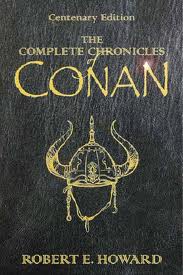 Howard: I also like Prospero, whom we learn is one of the few familiar enough with his king to speak easily with him. He clearly has the best interest of his king at heart and strives to give him good counsel. I like that he’s not perfect. It may just be a clever trick of REH’s to show us a little more what Prospero looks like, but I love that he turns to consider himself in the mirror, suggesting that he’s just a little vain. I wish that he turned up in more Conan stories.
Howard: I also like Prospero, whom we learn is one of the few familiar enough with his king to speak easily with him. He clearly has the best interest of his king at heart and strives to give him good counsel. I like that he’s not perfect. It may just be a clever trick of REH’s to show us a little more what Prospero looks like, but I love that he turns to consider himself in the mirror, suggesting that he’s just a little vain. I wish that he turned up in more Conan stories.
Bill: As do I. Looking at the Kull story, Propero is clearly the analog to Brule, Kull’s great Pictish friend who appears in all or nearly all of his other adventures. I like that Prospero essentially inherits that role, that his character is richer and larger-seeming because of, I suspect, that feeling for those older characters that REH was building from. We can believe in Prospero and Conan’s friendship even though we never really see it.
Howard: Part III begins to ramp things up. Yes, it’s a bit awkward that we get Thoth-Amon’s backstory in dialogue and that Dion just happens to have the ring, but I still kind of love it, particularly the way REH handles the noble who doesn’t really pay attention to anything the slave’s saying and loses his life as a result, or the way we’re shown Thoth-Amon’s duplicity and ruthlessness. This may not be top drawer Conan, but it’s surely entertaining. And this section concludes what may be the finest atmospheric writing in the entire story. From the point when Thoth-Amon kills Dion to the end of the section is pure prose poetry, Howard at his very best.
Bill: I agree — the first time I read the story I may have felt more strongly that some of these early sections were flawed or awkwardly paced, but it’s also rather efficient storytelling, and certainly well within the conventions of its day. The summoning scene, where Thoth-Amon doesn’t turn around despite the cold wind at his back, was creepy excellence.
Howard: With all the motivations out of the way, Robert E. Howard gets to exciting action and combat, although there’s a brief detour to the halls of an ancient sage in the land of dreams before we get finally to the explosive conclusion, drawn with the stunning clarity Howard is rightly famed for. It’s a thrill ride, but in the end it’s a little disjointed, and once you know the history of the tale as a revision from a Kull story the reasons are obvious. I don’t think I’m the only one who finds “By This Axe I Rule” a stronger piece, but REH, professional in need of a paycheck that he was, re-imagined it by stuffing it full of supernatural incidents so it would sell to Weird Tales. Once you’ve read THAT yarn, “The Phoenix on the Sword” seems more slap dash, although it did give editor Farnsworth Wright what he wanted.
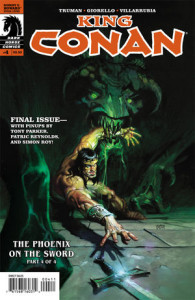 Bill: Both stories have that somewhat unusual structure in which we arrive at our protagonist only after hearing about him from minor characters, and I’ve read that they were inspired by Shakespeare’s Julius Caesar, which would help explain the focus on the conspirators. But I think “Phoenix” is a superior story to “Axe” because it seems to better integrate those two plot lines. The Kull story is indeed a good one, and in both pieces REH elevated the simple conflict with a thematically unified rumination on kingship, freedom, slavery, and civilization. But I think the Thoth-Amon element functions both to give us some cool weird horror, and to further hit at those themes. With Thoth-Amon, the conspirators themselves are undone by the same base human nature that led to them wanting to assassinate Conan in the first place, and their attack on the King is spoiled not by a loyalist, but by yet another betrayer. Like Thoth-Amon’s ring, they are eating their own tail, and Conan stands oddly outside and apart from all that in a way that Kull doesn’t. The monster Conan slays wasn’t even meant for him, his spiritual aid is clearly granted more to the King of Aquilonia than any Conan the Cimmerian. Even as a King, he’s more of an outsider to this world than he ever was as a thief or mercenary.
Bill: Both stories have that somewhat unusual structure in which we arrive at our protagonist only after hearing about him from minor characters, and I’ve read that they were inspired by Shakespeare’s Julius Caesar, which would help explain the focus on the conspirators. But I think “Phoenix” is a superior story to “Axe” because it seems to better integrate those two plot lines. The Kull story is indeed a good one, and in both pieces REH elevated the simple conflict with a thematically unified rumination on kingship, freedom, slavery, and civilization. But I think the Thoth-Amon element functions both to give us some cool weird horror, and to further hit at those themes. With Thoth-Amon, the conspirators themselves are undone by the same base human nature that led to them wanting to assassinate Conan in the first place, and their attack on the King is spoiled not by a loyalist, but by yet another betrayer. Like Thoth-Amon’s ring, they are eating their own tail, and Conan stands oddly outside and apart from all that in a way that Kull doesn’t. The monster Conan slays wasn’t even meant for him, his spiritual aid is clearly granted more to the King of Aquilonia than any Conan the Cimmerian. Even as a King, he’s more of an outsider to this world than he ever was as a thief or mercenary.
Howard: Huh — alright, maybe you’ve convinced me to reconsider which of the tales I find superior. I may have to re-read “By this Axe I Rule” tonight and compare them freshly. I’m particularly impressed with your analysis re: the outsider, and how Conan remains one throughout.
Whatever the rest of you thought of the story’s merits and flaws, rest assured that there are stronger Conan stories yet to come, although I’m not sure next week’s is among them. I haven’t revisited it even half as often as the one that lies three weeks out. In any case, join us next week for “The Frost Giant’s Daughter” and feel free to comment below!
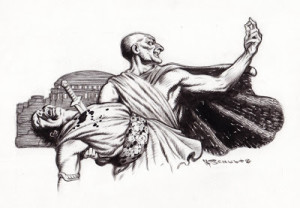
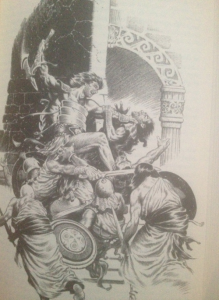
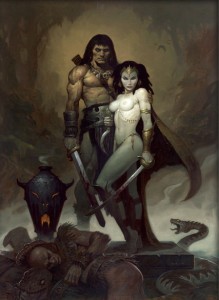
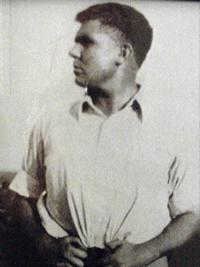
14 Comments